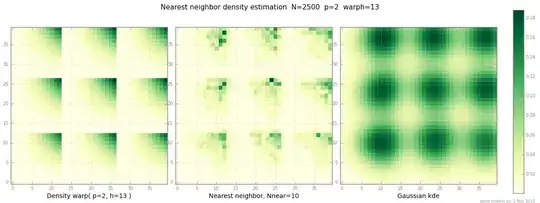Can anyone report on their experience with an adaptive kernel density estimator?
(There are many synonyms:
adaptive | variable | variable-width, KDE | histogram | interpolator ...)
Variable kernel density estimation
says "we vary the width of the kernel in different regions of the sample space.
There are two methods ..."
actually, more:
neighbors within some radius,
KNN nearest neighbors (K usually fixed),
Kd trees, multigrid...
Of course no single method can do everything,
but adaptive methods look attractive.
See for example the nice picture of an adaptive 2d mesh in
Finite element method.
I'd like to hear what worked / what didn't work for real data, especially >= 100k scattered data points in 2d or 3d.
Added 2 Nov: here's a plot of a "clumpy" density (piecewise x^2 * y^2),
a nearest-neighbor estimate, and Gaussian KDE with Scott's factor.
While one (1) example doesn't prove anything,
it does show that NN can fit sharp hills reasonably well
(and, using KD trees, is fast in 2d, 3d ...)
